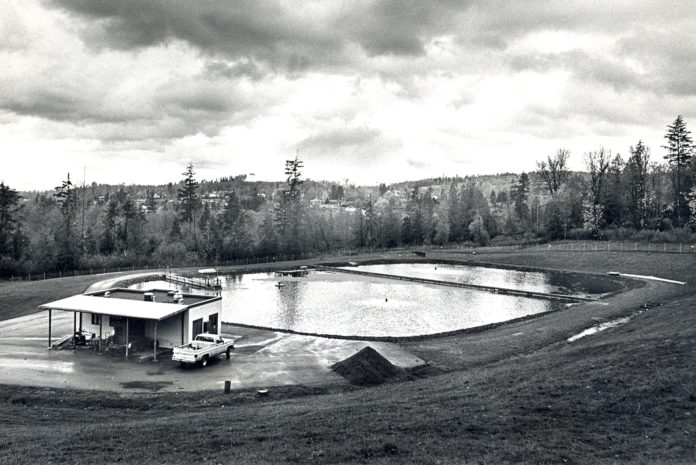Reports of recent algae blooms in Lake Sawyer call to mind the ill-fated history of the Black Diamond sewage treatment plant, shown here in this northeast facing photo by Paul Miller taken in November 1985.
The accompanying Seattle Times article from Nov. 20 noted, “Black Diamond’s sewage system, consisting of two lagoons and a marshland, is not removing enough of the pollutants.” Prior to 1983, city sewage was disposed of through individual or community septic tanks and drainfields, many in poor or failing conditions.
A 1979 study by Kramer, Chin & Mayo proposed a new system of gravity sewers transporting effluent to aerated ponds for primary treatment capture in marshland lagoons. The plan included annual harvest of the aquatic plants which were expected to digest organics and nutrients.
The project was financed by the EPA’s Innovative and Alternative Technology Program and operational by early 1983. But, the actual design eliminated the planned lagoons and plant harvest in favor of direct discharge to the marshlands.
The selected discharge areas surrounded Rock Creek which flowed into Lake Sawyer. By the time of this 1985 photo, testing indicated that natural capture of nutrients was not effective and downstream waters, primarily Lake Sawyer had experienced unprecedented algae blooms. A flurry of accusations, studies, and reports concluded that the sewage plant and related system had failed.
It took several years to decide upon a replacement design amid fears and newspaper headlines suggesting Lake Sawyer might be doomed. Finger-pointing and claims of foot-dragging followed, but by November 1992 a new $12 million system became operational.
Since then Black Diamond’s sewage has been pumped through transmission lines to the Metro regional treatment plant in Renton, from whence it is discharged to Puget Sound.







